The octet rule is - Study guides, Class notes & Summaries
Looking for the best study guides, study notes and summaries about The octet rule is? On this page you'll find 404 study documents about The octet rule is.
Page 4 out of 404 results
Sort by
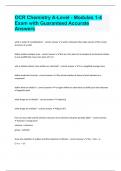
-
OCR Chemistry A-Level - Modules 1-4 Exam with Guaranteed Accurate Answers
- Exam (elaborations) • 10 pages • 2024
-
- $11.49
- + learn more
what is water of crystallisation? - correct answer water molecules that make up part of the crystal structure of a solid define relative isotopic mass - correct answer the ass of an atom of an isotope of an element relative to one twelfth the mass of an atom of C-12 why is relative atomic mass written as a decimal? - correct answer it is a weighted average mass define molecular formula - correct answer the actual number of atoms of each element in a compound define what an orbital is...
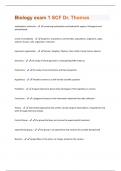
-
Biology exam 1 SCF Dr. Thomas Verified Questions And Answers With Verified Updates
- Exam (elaborations) • 7 pages • 2024
- Available in package deal
-
- $7.99
- + learn more
amphipathic molecules - containing hydrophobic and hydrophilic regions. Detergents and phospholipids Levels of complexity - biosphere, ecosystems, communities, populations, organisms, organ systems, tissues, cells, organelles, molecules taxonomic organization - Domain, Kingdom, Phylum, Class, Order, Family, Genes, Species Genomics - the study of whole genomes or total genetic/DNA make up Proteomics - the study of sets of proteins and their properties Hypothesis - Tentative answer to a wel...
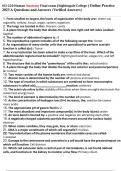
-
SCI-220 Human Anatomy Final exam (Nightingale College ) Online Practice 2023 A Questions and Answers (Verified Answers)
- Exam (elaborations) • 12 pages • 2024
-
Available in package deal
-
- $9.49
- + learn more
1. From smallest to largest, the levels of organization of the body are:: chemi- cal, organelle, cellular, tissue, organ, system, organism. 2. The lungs are located in the:: thoracic cavity 3. A plane through the body that divides the body into right and left sides is called:: Sagittal 4. The number of abdominal regions is:: 9 5. The reproductive system includes all of the following except the: Ureter 6. An organization of many similar cells that are specialized to perform a certain functio...
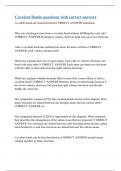
-
Covalent Bonds questions with correct answers
- Exam (elaborations) • 3 pages • 2023
-
- $11.99
- + learn more
Covalent bonds are formed between CORRECT ANSWER nonmetals Why can a hydrogen atom form a covalent bond without fulfilling the octet rule? CORRECT ANSWER Hydrogen's valence shell can hold only up to two electrons. After a covalent bond has stabilized an atom, the atom will have CORRECT ANSWER a full valence electron shell. What best explains how two oxygen atoms, each with six valence electrons, can bond with each other? CORRECT ANSWER Each atom can share two electrons with the other s...
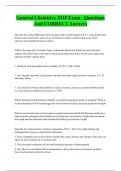
-
General Chemistry TOP Exam Questions And CORRECT Answers
- Exam (elaborations) • 65 pages • 2024
-
- $9.99
- + learn more
Describe the atomic differences between Ionic and Covalent bonds. 1. Ionic bonds form between ions and involve gain or loss of electrons, while covalent bonds occur when electrons are shared between two atoms What is the octet rule? List three types of elements that do not follow the octet rule and explain why. Octet rule=atoms tend to bond with other atoms so they have eight outer electrons in their valence shell 1. Elements with incomplete octets, includes: H, He, Li, Be, and B. 2. ...
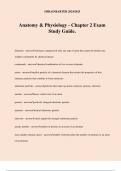
-
Anatomy & Physiology - Chapter 2 Exam Study Guide.
- Exam (elaborations) • 10 pages • 2024
-
- $11.49
- + learn more
Anatomy & Physiology - Chapter 2 Exam Study Guide. Elements - answersubstance composed of only one type of atom that cannot be broken into simpler constituents by chemical means compounds - answerchemical combination of two or more elements atoms - answersmallest particle of a chemical element that retains the properties of that element; particles that combine to form molecules subatomic particles - answerparticles that make up atoms; neutrons, protons, electrons nucleus - answerdense, c...
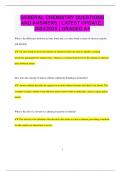
-
GENERAL CHEMISTRY QUESTIONS AND ANSWERS | LATEST UPDATE | 2024/2025 | GRADED A+
- Exam (elaborations) • 12 pages • 2024
- Available in package deal
-
- $10.11
- + learn more
GENERAL CHEMISTRY QUESTIONS AND ANSWERS | LATEST UPDATE | 2024/2025 | GRADED A+ What is the difference between an ionic bond and a covalent bond in terms of electron transfer and sharing? An ionic bond involves the transfer of electrons from one atom to another, creating positively and negatively charged ions, whereas a covalent bond involves the sharing of electron pairs between atoms. How does the concept of atomic orbitals explain the bonding in molecules? Atomic orbitals des...
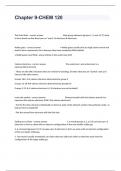
-
Chapter 9-CHEM 120 With All Complete And Verified Answers.
- Exam (elaborations) • 7 pages • 2024
-
- $12.99
- + learn more
The Octet Rule - correct answer Main group elements (groups 1, 2, and 13-17) tend to form bonds so that they have an "octet" of electrons (8 electrons) Noble gases - correct answer • Noble gases usually exist as single atoms and do not tend to form compounds; this is because they have completely filled orbitals. • Noble gases have filled s and p orbitals in the outermost shell Valence electrons - correct ans...
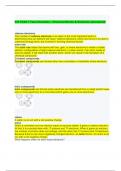
-
ATI TEAS 7 Test Chemistry - Chemical Bonds & Solutions (Answered)
- Exam (elaborations) • 5 pages • 2024
-
- $9.99
- + learn more
ATI TEAS 7 Test Chemistry - Chemical Bonds & Solutions (Answered) valence electrons The number of valence electrons in an atom is the most important factor in determining how an element will react. Valence electrons, which are found in an atom’s outermost energy level, are involved in forming chemical bonds. octet rule The octet rule states that atoms will lose, gain, or share electrons to obtain a stable electron configuration of eight valence electrons. In other words, if an atom nee...
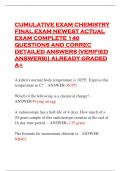
-
CUMULATIVE EXAM CHEMISTRY FINAL EXAM NEWEST ACTUAL EXAM COMPLETE 140 QUESTIONS AND CORREC DETAILED ANSWERS (VERIFIED ANSWERS)| ALREADY GRADED A+ A kitten's normal body temperature is 102ºF. Express this temperature in Cº. - ANSWER-38.9ºC Which of the f
- Exam (elaborations) • 25 pages • 2024
-
- $13.99
- + learn more
CUMULATIVE EXAM CHEMISTRY FINAL EXAM NEWEST ACTUAL EXAM COMPLETE 140 QUESTIONS AND CORREC DETAILED ANSWERS (VERIFIED ANSWERS)| ALREADY GRADED A+ A kitten's normal body temperature is 102ºF. Express this temperature in Cº. - ANSWER-38.9ºC Which of the following is a chemical change? - ANSWER-Frying an egg A radioisotope has a half-life of 4 days. How much of a 20-gram sample of this radioisotope remains at the end of 16 day time period. - ANSWER-1.25 gram The formula for ammoniu...

How did he do that? By selling his study resources on Stuvia. Try it yourself! Discover all about earning on Stuvia


